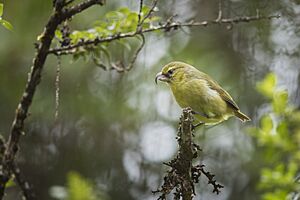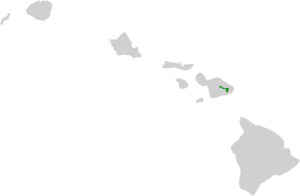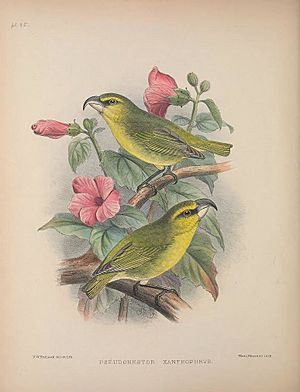Maui parrotbill facts for kids
The Kiwikiu (pronounced "kee-wee-kee-oo"), also known as the Maui parrotbill, is a special bird found only on the island of Maui in Hawaii. Its scientific name is Pseudonestor xanthophrys. This unique bird is a type of Hawaiian honeycreeper. It lives in wet and moist forests on the slopes of Haleakalā volcano, at elevations between 1,200 and 2,150 meters (about 3,900 to 7,000 feet).
Sadly, the Kiwikiu is Critically Endangered, meaning it's at very high risk of disappearing forever. In 2016, there were thought to be only 250 to 540 of these birds left. More recent counts suggest there are now fewer than 150 individuals. Long ago, Kiwikiu also lived in drier forests and on the island of Molokaʻi.
Quick facts for kids Kiwikiu (Maui parrotbill) |
|
|---|---|
 |
|
| Conservation status | |
| Scientific classification | |
| Genus: |
Pseudonestor
|
| Species: |
xanthophrys
|
 |
|
Contents
What Does the Kiwikiu Look Like?
The Kiwikiu is one of the bigger Hawaiian honeycreepers. It is about 14 centimeters (5.5 inches) long and weighs between 20 and 25 grams (less than an ounce). Imagine a bird about the size of a small sparrow!
This bird has bright yellow feathers on its chest, cheeks, and belly. Its wings, head, tail, and back are olive-green. It also has a bright yellow stripe above its eye, like an eyebrow.
The Kiwikiu's beak is very special. The top part is dark gray and hooked, while the bottom part is pale ivory and shaped like a chisel. This unique beak helps it find food. Male Kiwikiu are a bit bigger and have larger beaks than females. Young Kiwikiu birds are gray-green on top and light gray underneath.
Kiwikiu Calls and Songs
The Kiwikiu makes a short "chip" sound. It chirps this sound every three to five seconds. This call is similar to another Hawaiian bird, the Maui Nui ʻalauahio.
Its song includes "cheer" notes. These notes are slower and sound richer than the song of the ʻAkepa. Sometimes, the Kiwikiu also sings a short tune that sounds like "cheer-wee."
What Do Kiwikiu Eat?
The Kiwikiu is an insectivore, which means it mainly eats insects. It has a very strong beak and powerful jaw muscles. It uses these to pull off bark and wood from small trees and shrubs.
Some of its favorite trees include ʻākala, kanawao, and ʻōhiʻa lehua. Underneath the bark, it finds tasty insects to eat. The Kiwikiu also bites into fruits to look for insects hidden inside. It especially loves moth pupae and beetle larvae.
A pair of Kiwikiu birds will search for food in their own area, which is about 2.3 hectares (5.7 acres). They protect this area from other Kiwikiu birds.
Kiwikiu Life Cycle and Reproduction
Kiwikiu birds are monogamous, meaning they stay with one partner. They breed between November and June each year.
The female Kiwikiu builds a cup-shaped nest. She uses Usnea lichens and pūkiawe twigs for the nest. These nests are usually placed high up, about 12 meters (39 feet) above the forest floor.
Each breeding season, a pair of Kiwikiu usually raises just one baby bird, called a nestling. The female sits on the egg to keep it warm for 16 days. Once the baby bird hatches and grows feathers (called a fledgling), it stays with its parents for five to eight months. During this time, it learns how to find food on its own.
Where Do Kiwikiu Live?
Today, the Kiwikiu lives only in special, untouched wet forests. These forests are mostly filled with ʻōhiʻa lehua trees. They also have smaller areas of ʻōhiʻa-koa forests.
The places where Kiwikiu live have many small trees, shrubs, and ferns growing close together. These areas are found between Puʻu ʻAlaea, Kuhiwa Valley, Lake Waianapanapa, and upper Kīpahulu Valley. This entire habitat is less than 2,020 hectares (5,000 acres) and is located at high elevations, from 1,310 to 2,070 meters (about 4,300 to 6,800 feet).
The Hawaiian Name: Kiwikiu
For a long time, the Pseudonestor xanthophrys bird did not have a common name in the Hawaiian language. The Maui Forest Bird Recovery Project asked the Hawaiian Lexicon Committee to create one.
In September 2010, a special naming ceremony was held in the bird's forest home. They chose the name Kiwikiu. The first part, "kiwi," means bent or curved. This describes the unique shape of the bird's beak. The second part, "kiu," has two meanings. It refers to the bird's shy and secretive nature. It also means a cold, chilly wind, like the breezes found in the Kiwikiu's mountain habitat.
Protecting the Kiwikiu: Conservation Efforts
The Kiwikiu's natural home is in the wet and moist forests of Maui. However, this bird faces many dangers.
Why Are Kiwikiu in Danger?
One big threat is habitat loss. Much of the land where Kiwikiu used to live was changed. It was used for farming, cutting down trees, or letting animals graze.
New animals and insects brought to Hawaii also cause problems. Mosquitoes spread a sickness called avian malaria, which makes Kiwikiu very sick. Rats eat the birds' eggs and young chicks. Wild pigs dig up the plants where Kiwikiu find food. Pigs also create muddy puddles, which are perfect places for mosquitoes to lay their eggs.
How Are We Helping Kiwikiu?
The Kiwikiu was listed as an endangered species in 1967. This means it received special protection. In 1984, a recovery plan was created for birds on Maui and Molokaʻi. This plan included building fences in East Maui to keep out wild animals. It also involved removing wild pigs and other hoofed animals.
A program to breed Kiwikiu in captivity also started. The first chick from this program hatched in 2003. The Maui Forest Bird Recovery Project does a lot of research in the wild to help these birds.
A survey in 2009 suggested that the Kiwikiu population in the Waikamoi Preserve might be stable or even growing. This was partly because native shrubs in the area had tripled. However, more recent studies found that the population actually dropped a lot after 2001. This is because climate change has made higher-up forests, where Kiwikiu live, more welcoming to mosquitoes.
In 2019, an effort was made to move some Kiwikiu to a restored area on the dry side of Haleakalā. Sadly, most of these birds got avian malaria and did not survive, even though the habitat itself was good.
Scientists have predicted that if mosquito populations continue to grow, the Kiwikiu might disappear from the wild by 2027. Because of this serious concern, several new conservation plans are being put into action.
These plans include:
- Temporarily raising a large group of Kiwikiu in zoos on the mainland United States. This would create a safe population away from avian malaria. Zoos like the National Aviary in Pennsylvania, the Smithsonian Conservation Biology Institute in Virginia, and the Tracy Aviary in Utah might help.
- Possibly introducing a wild population to the island of Hawaii as a backup.
- Managing and restoring more habitat on Maui for future releases of birds.
- Developing new ways to control predators.
- Working on large-scale mosquito control in the Kiwikiu's natural habitat.
To start the captive breeding program, 15 male and 15 female wild birds will be moved. Taking so many birds from the small wild population is a big step. However, it is hoped that this will create a safe population that can breed in captivity, protected from avian malaria.
See also
 In Spanish: Pseudonestor xanthophrys para niños
In Spanish: Pseudonestor xanthophrys para niños




